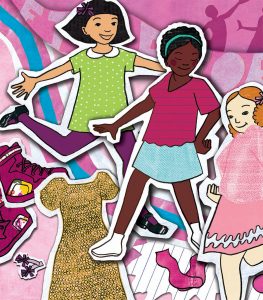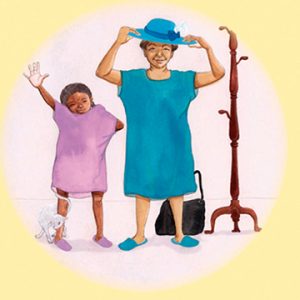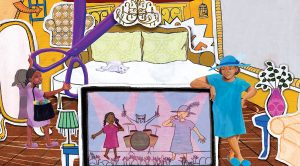 Released this past May, Sunday Shopping tells a whimsical story of a girl and her grandma who go “shopping” through the newspaper ads every Sunday. We interviewed author Sally Derby and illustrator Shadra Strickland about their creative processes, the children’s book publishing industry, and encouraging children to write more.
Released this past May, Sunday Shopping tells a whimsical story of a girl and her grandma who go “shopping” through the newspaper ads every Sunday. We interviewed author Sally Derby and illustrator Shadra Strickland about their creative processes, the children’s book publishing industry, and encouraging children to write more.
 Sally Derby, author
Sally Derby, author
1. Sunday Shopping is not exactly a story about economic need, but the book subtly suggests that the family doesn’t have a lot of disposable income. Why did you decide to address this subject in this particular way? Are there any picture books that address poverty in a way you really love or admire?
As long as your basic needs for food and shelter are met, then poverty is a point of view and no matter what anyone else thinks, if you are happy with what you have, you are rich. In this country, so many of us have so much. I wanted to show a child who is happy without all the possessions many other families take for granted. In this regard, I have always loved Nikki Giovanni’s poem “Nikki-Rosa” about growing up in Woodlawn, a suburb of Cincinnati near where I lived. Just listen to the last lines of that lovely poem:
because they never understand
Black love is Black wealth and they’ll
probably talk about my hard childhood
and never understand that
all the while I was quite happy
I wasn’t Black, but I was a child of the depression, and I spent some of the happiest days of my childhood in my great-grandparents’ house in Elkhart, Indiana, outdoor plumbing and all. If that house had been set down next door to Nikki Rosa’s it probably would have fit right in.
2. Although you are white, many of your books (including Sunday Shopping) are told from the perspective of black characters. Why do you decide to write cross-culturally, and what kind of research do you do to make sure you get it right?
 I know my answer will sound unbelievable to many, but I don’t “decide” to write cross-culturally or any other way. When I start to write a story I usually have only a fragment of something in my mind—a scene, a character, a scrap of conversation. But as soon as my fingers touch the keyboard I’ll hear a voice saying the words I type, and that voice determines everything that follows. As I listen, the story becomes clearer to me and as long as I don’t start sticking in my own words I have to trust that the story is going where it’s meant to go.
I know my answer will sound unbelievable to many, but I don’t “decide” to write cross-culturally or any other way. When I start to write a story I usually have only a fragment of something in my mind—a scene, a character, a scrap of conversation. But as soon as my fingers touch the keyboard I’ll hear a voice saying the words I type, and that voice determines everything that follows. As I listen, the story becomes clearer to me and as long as I don’t start sticking in my own words I have to trust that the story is going where it’s meant to go.
I feel very lucky that many of the voices happen to have come from Black characters. I always love listening to and learning from vernacular speech—Yiddish, Pennsylvania-Dutch, Appalachian, Urban Black. Before the Dictionary of American English went on line, I saved and scrimped to buy all six volumes for my own bookshelves. I could spend hours every day browsing in DARE and thoroughly enjoying myself.
I know many people think no one should write outside their own culture. But I think I have the right to write any way I want about anything I want. After I’ve written it, if I didn’t get the voice “right” people are free to say so and explain what is lacking or wrong.
I have had to do very little research for the three “cross-cultural” picture books I’ve written for Lee & Low, because the books’ narrators are talking about their experiences as little girls who just happen to be African American, experiences they might just as easily have had if they were Asian or Caucasian. Of course, they will have had experiences peculiar to children of their race, but they are not speaking of those. If they had been, I would have had much more research to do.
3. What advice do you have for other authors who are writing stories cross-culturally?
I have no advice about writing cross-culturally that differs from what I’d advise about any sort of writing. No matter the subject, approach your writing honestly and humbly. Treat your characters with respect. When adverse criticism comes (as it will, no matter who you are or how well you write) try to evaluate it honestly. If it’s worthwhile, learn from it, and if it isn’t, disregard it.
We are limited by our experiences and we tend to judge everything from our own point of view. We learn by allowing ourselves, and being allowed, to see through the eyes of people unlike us. Reading can expand our worldview by introducing us to those we are unlikely to meet, even sometimes to those we wouldn’t want to meet.
4. Many people feel that libraries are becoming obsolete, given the Internet and the wealth of information that exists now. As someone who has seen publishing evolve over the years, what is your opinion on the relevance of libraries in the “age of information”?
I’m an optimist. Movies didn’t replace books, and television hasn’t replaced books, and I don’t think the Internet will replace books either. Kindles have their place, but it’s still more satisfying to close the cover of a book than to push a button that returns you to a black screen. And besides the enjoyment of books, especially picture books, that you can touch and hold, I don’t think we can overestimate the value of being able to wander through a library when you are researching a subject. If you confine yourself to a Google search, you may be offered a plenitude of sources, but the order in which they are presented will necessarily influence your choice of what to read. What you write then may be solid and factual, but it won’t be nearly as interesting or original as it would have been if your eye had been caught by that odd little volume with the faded purple color on the bottom shelf of the 590’s.
—
Sally Derby is the author of books for children including the popular NO MUSH TODAY and MY STEPS, published by Lee & Low. Her books are notable for their heartfelt family stories told from a spot-on childlike point of view. The mother of six grown children, she lives in Cincinnati, Ohio, with her husband.
 Shadra Strickland, illustrator
Shadra Strickland, illustrator
1. What was your process for creating the unique and playful art in Sunday Shopping?
The art was made in many stages. The vignettes of Evie and Grandma in the bedroom were done in watercolor and gouache. I made line drawings of the imaginary scenes and scanned those in along with separate acrylic paintings of Evie and Grandma along with hand painted textures.
- Do you have a similar childhood experience to Evie, who pretends to go shopping with her grandma every Sunday?
I do! When I was little, I would ride the bus to my grandmother’s house after school while my mom was still teaching during the day. After my grandmother would finish her “stories” on television, most days I’d watch cartoons, but sometimes the JCPenny or Macy’s Wish Book would come in and we would spend hours looking through to pick out the things we wanted to buy. Often times, I would cut out the items I wanted to do my own shopping just like Evie. My grandmother is well into her 80s now and collects all of my books. When I shared Sunday Shopping with her, she gave a big laugh out loud and said, “This is you and me, aint it?”. It was the best validation I could ever get.
- You use a wide variety of media in your illustrations that vary from book to book. Do you have a favorite medium to work with? How did you decide which media to use for Sunday Shopping?
I love working in watercolor and gouache mostly, but when I read a manuscript, I usually have very strong visions of what it should look and feel like. Most stories have a strong visual element that is carried throughout. For Bird, it was Mekhai’s line drawings and Marcus’s hat. I knew from the start that Sunday Shopping would be driven by collage, but when I sat down to try and make collages, I failed miserably. It wasn’t until I found a youtube video of Michael Jackson and Roberta Flack singing “Free to be You and Me” that the idea of cut outs and digital collage came to the surface.
- Children are often encouraged to seek fields to go into other than art and other creative fields. How would you encourage a child who wants to become an artist or a writer?
I would give them opportunities to create. My mom made sure I always had lots of paper and pencils around and she would pose for me when I asked to draw her. Once she noticed how captivated I was with drawing she gave me full reign to do so. She introduced me to the art teacher at the high school where she worked, bought me lots of how-to books on how to draw, and enrolled me in art classes at one of our local community art centers. I never will forget taking a portraiture class at Callenwolde Art Center when I was around 11. I was the youngest artist there in a room full of grown ups. It completely changed my life. It was my first time having a real professional teach me how to draw.
- What were your favorite picture books as a child, and what are a few of your favorite picture books as an adult?
I read a lot of instructional books as a kid. Things like, “Where Does Rain Come From?”, and the like. I remember being completely enchanted by “The Snowy Day.” A little later on when Reading Rainbow was popular, I fell in love with “Just Us Women” by Pat Cummings. Now, as an avid pupil of picturebooks, it is hard to say which ones are my favorites. I do still love Bird. Everything about that book came together so perfectly. I also, love looking through all of Mirislov Sasek’s “This is…” books. What an amazing life! To be able to travel and draw and share that work with readers for years to come…amazing.
- Lee & Low Books has the New Voices Award to create opportunities for new writers of color. What would be a good way to create more opportunities for illustrators of color and illustrators from other underrepresented groups?
That’s a tough question. Though competitions are wonderful ways for I also think that inspiring and encouraging kids to tell their own stories is a great way to get them started on a long road to storytelling. As artists and writers of color, I believe that we must be examples for future writers and artists. School visits is still a great vehicle for this.
Being active in our communities is also important ways to motivate, and teach through example. Recently I volunteered to bring the Ezra Jack Keats Bookmaking Competition to Baltimore City this fall. My hope is that it will help connect multiple community organizations committed to literacy and the arts and inspire young writers and artists to take their work seriously at a young age so that they will continue to develop and pursue their talents as they get older. The winners will receive cash prizes and have their work displayed across city libraries in the summer.
I think that exposing people to what we do as artists and authors is the best way to help keep them inspired. I also believe that now with technology becoming more and more accessible to everyone, it has become much easier for artists and authors to get their stories out into the world.
—
Shadra Strickland is the illustrator of several children’s books including Lee & Low’s BIRD, winner of the Ezra Jack Keats New Illustrator Award and the Coretta Scott King/John Steptoe Award for New Talent in Illustration. Along with illustrating and writing stories, Strickland loves to make drawings during her travels around the country and the world. She lives in Baltimore, where she also teaches illustration at Maryland Institute College of Art. Her website isjumpin.shadrastrickland.com.
Purchase a copy of Sunday Shopping here.








